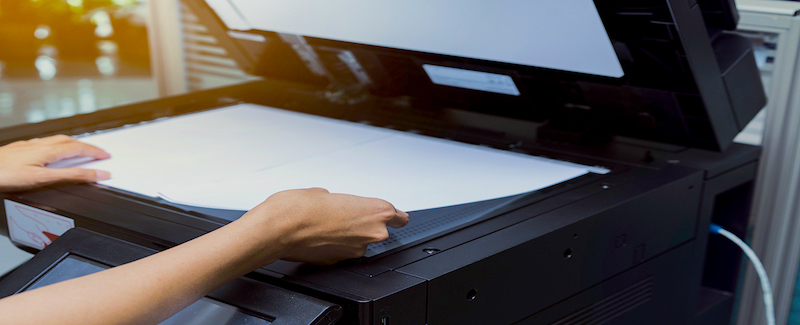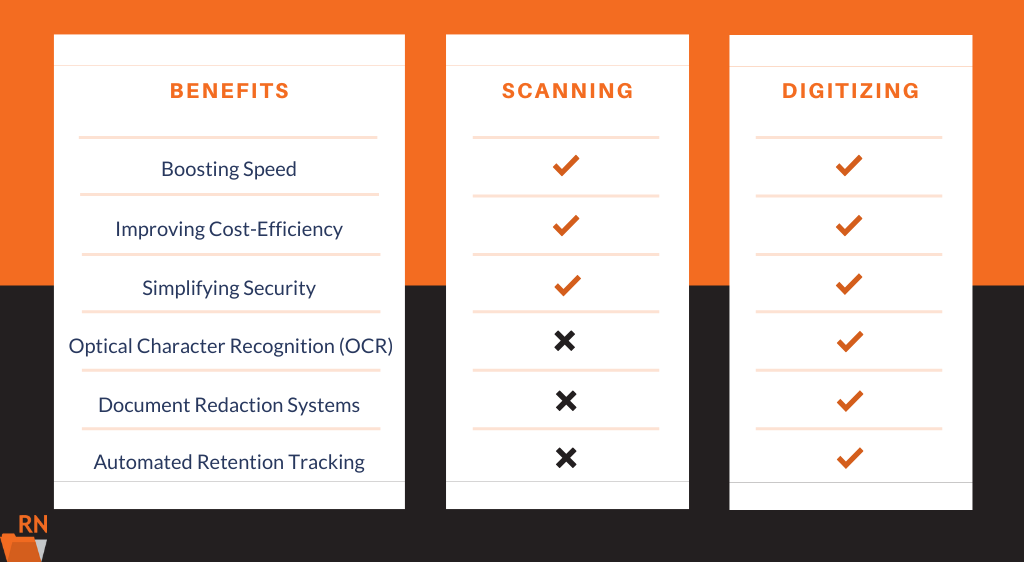
While the two terms are often used interchangeably, there are several unique benefits and differences between scanning and digitizing. In short, scanning just takes an image of the document you are trying to convert. Document digitizing enhances your scanning service, making your documents editable and processes more automated.
What’s the Difference Between Document Scanning and Digitization?
Document scanning and digitizing are often mistaken to be the same. Contrary to popular belief, they are actually two separate processes for converting a paper document to a digital copy.
There are several differences. But, what truly separates them is their usability—while both create digital documents, only digitizing can create editable versions.
Scanning Defined
Document scanning is otherwise known as “document imaging.” Just like it sounds, when a document is scanned, a picture—or “image”—of the document is taken and converted to a digital file.
Digitizing Defined
Document digitizing builds on scanning’s conversion by implementing additional tools during the process. This makes new digital files editable as opposed to being just static images.
The Benefits of Document Scanning
There are multiple advantages to scanning documents, with some of the primary examples being benefits like time and cost-efficiency, simplified security, and saving space.
Boosting Speed
Document scanning can improve workflow in several ways such as the ability to access digital files remotely—in turn removing time spent filing and re-filing hard copies.
In addition to accessibility, using document management system (DMS) software to manage digital files can also improve the efficiency of sharing, organizing, and collaborating on documents.
Improving Cost-Efficiency
Document scanning saves money in two primary ways: time and space. The ability to quickly track down papers in turn helps to open up extra time for more productive purposes.
Going paperless also opens up space once used for storage. Rather than using filing cabinets in your office, the valuable real estate can be used for more revenue-generating employees instead.
Simplifying Security
Scanning improves security with the ability to easily keep track of files. In turn, this lowers the chances of files being lost or stolen.
In terms of natural disasters and environmental damage, automated backups for scanned documents can also be configured. Therefore, there can always be a secure and up-to-date copy stored safely off-site.
The Advantages of Document Digitizing
The benefits of digitizing work like an extension of scanning, helping to improve the usability of digital documents with tools like optical character recognition (OCR), redaction, and automated retention tracking.
Optical Character Recognition (OCR)
OCR is used during the scanning process where characters on a page are converted to machine-encoded text.
Rather than a simple image of the file, the encoded text can be edited and manipulated—helping to make newly digitized documents more usable.
Document Redaction Systems
During digitization, documents can also be redacted to protect any sensitive information they contain.
Besides simplifying the process, digital redaction is also more secure. In the past, many hard-copy redactions were ink-based. These could be removed by a motivated thief. A digital redaction is permanent.
Automated Retention Tracking
When files like medical records are digitized, digital document systems can often be configured to track their legal retention periods.
By helping to ensure no information can slip through the cracks, these automated retention tracking systems help to simplify managing record retention and to avoid any noncompliance penalties or fines.
Upgrade Your Business With Document Digitizing Today!
Join Amazon, Google, and other companies we’ve helped to find the right records scanning and digitizing options to match their paperless document management needs.
To get started with free and no-obligation quotes on document scanning, digitizing, and other management services from nearby providers, fill out the form, give us a call at (866) 385-3706, or contact us directly with our live chat. Within minutes of receiving your request, you’ll be connected to one of our experts in your area who is ready to help.














